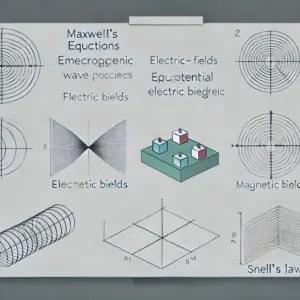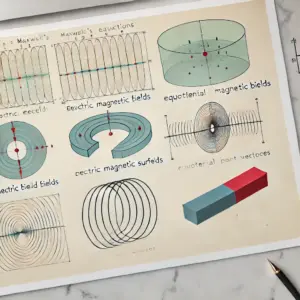EMT Notes Pdf – Electromagnetic Theory JNTU Free Lecture Notes Download
Here you can download the free lecture Notes of Electromagnetic Theory Pdf Notes – EMT Pdf Notes materials with multiple file links to download. Electromagnetic Theory Notes Pdf – EMT Notes Pdf book starts with the topics covering Sources&effects of electromagnetic field,electromagnetic, columbs law, Magnetostatics, Electrodynamic field, Electromagnetic waves, etc.

Electromagnetic Theory Notes – EMT Notes | Free Lecture Notes Download 2024-SW
Electromagnetic Theory Pdf Notes – EMT Pdf Notes
Latest Material Links
Complete Notes
Link – Complete Notes
Unit 1
Link – Unit 1 Notes
Unit 2
Link – Unit 2 Notes
Unit 3
Link – Unit 3 Notes
Unit 4
Link – Unit 4 Notes
Unit 5
Link – Unit 5 Notes
Old Material Links
Complete Notes
Link:Complete Notes
Unit 1
Link:Unit 1 Notes
Unit 2
Link:Unit 2 Notes
Unit 3
Link:Unit 3 Notes
Unit 4
Link:Unit 4 Notes
Unit 5
Link:Unit 5 Notes
Note :- These notes are according to the R09 Syllabus book of JNTU.In R13 and R15,8-units of R09 syllabus are combined into 5-units in R13 and R15 syllabus. If you have any doubts please refer to the JNTU Syllabus Book.
Electromagnetic Theory Notes Pdf – ET Pdf Notes Free Download
Electromagnetic Theory is a fundamental branch of physics and engineering, exploring the interaction between electric and magnetic fields and their applications in various technologies. This course provides a comprehensive understanding of the principles governing electromagnetic fields, including their sources, effects, and propagation. These notes are meticulously designed to align with the JNTU syllabus, offering B.Tech students a thorough grasp of electromagnetic theory concepts.
Electromagnetic Theory Notes| PDF, Syllabus, Books | B Tech (2025)
Electromagnetic Theory is crucial for understanding how electric and magnetic fields interact and affect materials and systems. This course delves into fundamental concepts, including electrostatics, magnetostatics, electrodynamics, and electromagnetic waves. These notes provide a structured approach to learning these concepts, enhancing students’ theoretical and practical understanding.
The notes are organized into five units, following the JNTU syllabus, ensuring students receive a holistic education in electromagnetic theory.
The following topics are covered in Electromagnetic Theory Handwritten Notes
Unit 1: Sources and Effects of Electromagnetic Fields
- Electromagnetic Fields:
Electromagnetic fields are produced by charged particles and have both electric and magnetic components. This section covers the sources and effects of electromagnetic fields, including static and dynamic fields. - Types of Fields:
Understanding different types of fields is essential for analyzing electromagnetic phenomena. This topic covers scalar fields, vector fields, electric fields, and magnetic fields, explaining their characteristics and interactions. - Scalar and Vector Fields:
Scalar fields are characterized by a magnitude, while vector fields have both magnitude and direction. This section explores the properties and applications of scalar and vector fields in electromagnetics. - Coordinate Systems:
Coordinate systems are used to describe the position of points in space. This topic covers Cartesian, cylindrical, and spherical coordinate systems, and explains their applications in electromagnetic field analysis.
Unit 2: Electrostatics
- Coulomb’s Law:
Coulomb’s Law describes the force between two point charges. This section covers the vector form of Coulomb’s Law and its applications in calculating electric field intensity. - Electric Field Intensity:
Electric field intensity is the force exerted per unit charge. This topic covers the calculation of electric field intensity due to point charges, line charges, surface charges, and volume charges. - Gauss’s Law:
Gauss’s Law relates the electric flux through a closed surface to the charge enclosed by that surface. This section explains the application of Gauss’s Law in calculating electric fields in symmetrical charge distributions. - Electric Potential:
Electric potential is the work done to move a unit charge from a reference point to a specific point in an electric field. This topic covers equipotential surfaces and the relationship between electric field and potential. - Electric Field in Dielectrics:
Dielectrics are insulating materials that affect electric fields. This section explores the behavior of electric fields in dielectric materials, including polarization, dielectric constant, and dielectric strength.
Unit 3: Magnetostatics
- Magnetic Fields and Forces:
Magnetostatics deals with magnetic fields produced by steady currents. This section covers the relationship between magnetic induction (B) and magnetic field strength (H), and the forces experienced by current-carrying conductors. - Maxwell’s Equations for Static Fields:
Maxwell’s equations describe the behavior of electric and magnetic fields. This topic covers the integral and differential forms of Maxwell’s equations for static fields, including their applications. - Magnetic Scalar and Vector Potentials:
Scalar and vector potentials are used to describe magnetic fields. This section explores the Laplace and Poisson equations for scalar magnetic potential, and the concept of vector magnetic potential. - Inductance and Magnetic Forces:
Inductance is a property of electrical circuits that opposes changes in current. This topic covers the calculation of inductance for different configurations, such as coils and toroids, and the forces exerted by magnetic fields.
Unit 4: Electrodynamics
- Faraday’s Law of Electromagnetic Induction:
Faraday’s Law states that a changing magnetic field induces an electromotive force (EMF) in a closed loop. This section covers the principles and applications of electromagnetic induction. - Lenz’s Law and Its Applications:
Lenz’s Law describes the direction of induced currents in response to changing magnetic fields. This topic explores the applications of Lenz’s Law in electric motors, transformers, and generators. - Maxwell’s Equations for Time-Varying Fields:
Maxwell’s equations for time-varying fields describe the dynamic behavior of electric and magnetic fields. This section covers Ampère’s Law with Maxwell’s addition, Gauss’s Law for electric and magnetic fields, and the concept of displacement current. - Boundary Conditions for Electromagnetic Fields:
Boundary conditions describe the behavior of electromagnetic fields at the interface between different media. This topic covers the boundary conditions for electric and magnetic fields in time-varying situations. - Energy and Forces in Electromagnetic Fields:
Electromagnetic fields store and transfer energy. This section explores the concepts of energy density, Poynting vector, and the forces experienced by charges and currents in electromagnetic fields.
Unit 5: Electromagnetic Waves
- Wave Propagation and Characteristics:
Electromagnetic waves are oscillating electric and magnetic fields that propagate through space. This section covers the characteristics of electromagnetic waves, including wave velocity, wavelength, frequency, and amplitude. - Attenuation and Phase Constants:
Attenuation describes the reduction in wave amplitude as it propagates through a medium. This topic covers the attenuation and phase constants, and their impact on wave propagation. - Intrinsic Impedance and Propagation Constant:
Intrinsic impedance is the ratio of electric to magnetic field amplitudes in a wave. This section covers the calculation of intrinsic impedance and propagation constant for different media. - Electromagnetic Waves in Different Media:
Electromagnetic waves behave differently in various media, including free space, dielectrics, and conductors. This topic explores the propagation of electromagnetic waves in these media and the concept of skin depth. - Poynting Theorem and Vector:
The Poynting theorem describes the flow of energy in electromagnetic fields. This section covers the Poynting vector and its applications in calculating power and energy transfer in electromagnetic systems.
ET Notes and Study Material PDF Free Download
The ET Notes Pdf offers a comprehensive guide to understanding electromagnetic theory principles and applications. These notes provide detailed explanations, diagrams, and examples to enhance students’ learning experiences and facilitate their academic success.
Topics Covered in this ET Notes Pdf
The ET Notes Pdf covers essential topics such as electromagnetic fields, electrostatics, magnetostatics, electrodynamics, and electromagnetic waves. These topics are integral to understanding the principles of electromagnetics and their applications in modern technology.
ET Notes Pdf from JNTU
These notes are meticulously prepared to align with the JNTU syllabus, providing structured content that supports students in their academic pursuits. The notes are designed to help students master the concepts of electromagnetic theory, enabling them to excel in their studies and careers.
Always Choose Smartzworld to Download ET Notes PDF
Smartzworld is a trusted platform for accessing high-quality educational resources. By choosing Smartzworld, students gain access to reliable, accurate, and comprehensive study materials that support their learning and academic achievements.
Benefits of FREE ET Handwritten Notes PDF
- Concise and Clear Presentation of Complex Topics:
The handwritten notes offer clear explanations of complex concepts, making it easier for students to understand the material. - Aligns with the JNTU Curriculum for Better Preparation:
The notes are tailored to the JNTU syllabus, ensuring that students are well-prepared for exams and assessments. - Free Access to Quality Educational Resources:
Students can download the notes for free, providing access to valuable study materials without financial barriers. - Easy Download and Offline Access for Continuous Learning:
The notes are available for download in PDF format, allowing students to access the material offline and study at their convenience.
Frequently Asked Questions (FAQs)
Q1: Where can I download the Electromagnetic Theory Notes Pdf?
- You can download the notes from the provided links for each unit or the complete set from Smartzworld.
Q2: How to download the Electromagnetic Theory Notes Pdf?
- Click on the provided links to access the PDF files for each unit or the complete notes set.
Q3: How many modules are covered in Electromagnetic Theory Notes Pdf?
- The ET Notes Pdf covers five modules, each corresponding to a unit in the JNTU syllabus.
Q4: Topics Covered in Electromagnetic Theory Notes Pdf?
- The notes cover electromagnetic fields, electrostatics, magnetostatics, electrodynamics, and electromagnetic waves.
Q5: Where can I get the complete ET Handwritten Notes pdf FREE Download?
- You can download the complete handwritten notes for free from Smartzworld or the provided links above.
Q6: How to download ET Handwritten Notes pdf?
- Visit Smartzworld or use the download links provided to access the PDF files.
Q7: How to Download FREE Electromagnetic Theory Notes PDF?
- Simply click on the download links provided in this article to get your free copy of the ET notes.
Conclusion
The Electromagnetic Theory Notes Pdf is an invaluable resource for B.Tech students at JNTU. By providing detailed coverage of key topics, these notes support students in mastering the principles and applications of electromagnetics. With comprehensive explanations
How useful was this post?
Click on a star to rate it!
Average rating 4.6 / 5. Vote count: 27
No votes so far! Be the first to rate this post.


